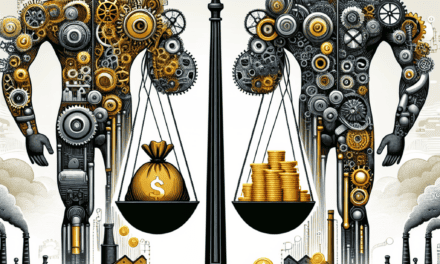“Amidst the Power Struggle, One AI Company Lights the Way to Victory.”
Introduction
In the rapidly evolving landscape of artificial intelligence, companies are increasingly facing a significant hurdle: electricity gridlock. As AI technologies demand ever-greater computational power, the strain on electrical grids has become a critical bottleneck, threatening to stifle innovation and growth. Amidst this challenging environment, one company has managed to navigate these constraints successfully, emerging as a leader in the field. By leveraging cutting-edge energy solutions and strategic partnerships, this company has not only overcome the gridlock but has also set a new standard for sustainable and efficient AI operations.
Understanding Electricity Gridlock: Challenges Faced by AI Companies
In recent years, the rapid advancement of artificial intelligence (AI) technologies has led to an unprecedented demand for computational power. This surge in demand has, in turn, placed significant pressure on electricity grids worldwide, as AI companies require vast amounts of energy to power their data centers and fuel their machine learning algorithms. The phenomenon, often referred to as electricity gridlock, presents a formidable challenge for AI companies striving to balance their energy needs with sustainability goals and operational efficiency. As the industry grapples with these challenges, one company has emerged victorious, setting a precedent for others to follow.
The core of the electricity gridlock issue lies in the energy-intensive nature of AI operations. Training complex AI models involves processing massive datasets, which necessitates the use of high-performance computing resources. These resources, typically housed in expansive data centers, consume substantial amounts of electricity, often leading to increased carbon emissions and heightened scrutiny from environmental advocates. Consequently, AI companies are under mounting pressure to find innovative solutions that mitigate their environmental impact while maintaining the computational power necessary for their operations.
In response to these challenges, many AI companies have begun exploring alternative energy sources and optimizing their data center operations. Renewable energy, such as solar and wind power, has become an attractive option for companies seeking to reduce their carbon footprint. By investing in renewable energy projects or purchasing renewable energy credits, AI companies can offset their electricity consumption and demonstrate a commitment to sustainability. Additionally, advancements in energy-efficient hardware and cooling technologies have enabled companies to reduce the energy consumption of their data centers, further alleviating the strain on electricity grids.
Despite these efforts, the path to overcoming electricity gridlock is fraught with obstacles. The intermittent nature of renewable energy sources poses a significant challenge, as AI companies require a consistent and reliable power supply to ensure uninterrupted operations. Moreover, the initial investment required to transition to renewable energy or upgrade data center infrastructure can be prohibitive for smaller companies or startups. As a result, many AI companies continue to rely on traditional energy sources, perpetuating the cycle of high energy consumption and environmental impact.
Amidst these challenges, one AI company has distinguished itself by successfully navigating the electricity gridlock conundrum. By adopting a multifaceted approach that combines renewable energy integration, energy-efficient technologies, and strategic partnerships, this company has managed to achieve a sustainable balance between its energy needs and environmental responsibilities. Through collaboration with local governments and utility providers, the company has secured access to a stable supply of renewable energy, ensuring the reliability of its operations. Furthermore, by investing in cutting-edge hardware and cooling solutions, the company has significantly reduced its data center energy consumption, setting a benchmark for industry peers.
The success of this company serves as a testament to the potential for innovation and collaboration in addressing the electricity gridlock challenge. As AI companies continue to expand and evolve, the lessons learned from this victory can inform future strategies and inspire others to pursue sustainable solutions. Ultimately, the path forward will require a concerted effort from industry stakeholders, policymakers, and energy providers to create an ecosystem that supports the growth of AI technologies while safeguarding the environment. In doing so, the industry can ensure that the benefits of AI are realized without compromising the planet’s future.
The Role of Renewable Energy in Solving AI Companies’ Power Issues
As the demand for artificial intelligence (AI) technologies continues to surge, AI companies are increasingly confronted with the challenge of securing sufficient power to fuel their energy-intensive operations. The rapid expansion of AI applications, from machine learning algorithms to data processing centers, has placed unprecedented pressure on electricity grids worldwide. This growing demand for energy has prompted a critical examination of how renewable energy sources can play a pivotal role in addressing these power issues. In this context, one company has emerged as a leader in integrating renewable energy solutions to overcome electricity gridlock, setting a precedent for the industry.
The energy consumption of AI systems is substantial, primarily due to the computational power required to process vast amounts of data. Traditional energy sources, such as fossil fuels, have long been the backbone of electricity generation. However, their environmental impact and finite nature have led to a growing consensus on the need for sustainable alternatives. Renewable energy sources, including solar, wind, and hydropower, offer a promising solution to the energy challenges faced by AI companies. These sources not only provide a sustainable means of power generation but also contribute to reducing the carbon footprint associated with AI operations.
Transitioning to renewable energy is not without its challenges. The intermittent nature of sources like solar and wind can lead to fluctuations in power supply, posing a significant hurdle for AI companies that require a consistent and reliable energy flow. However, advancements in energy storage technologies, such as batteries and grid-scale storage systems, are helping to mitigate these issues. By storing excess energy generated during peak production times, these technologies ensure a steady supply of power even when renewable sources are not actively generating electricity.
One company that has successfully navigated these challenges is GreenAI, a pioneer in integrating renewable energy into its AI operations. GreenAI has strategically invested in a combination of solar farms and wind turbines, complemented by state-of-the-art energy storage solutions. This approach has enabled the company to achieve a remarkable level of energy self-sufficiency, significantly reducing its reliance on traditional power grids. By doing so, GreenAI has not only ensured a stable power supply for its operations but has also set a benchmark for sustainability in the AI industry.
Moreover, GreenAI’s commitment to renewable energy extends beyond its operational needs. The company actively collaborates with local communities and governments to promote the adoption of renewable energy solutions. By sharing its expertise and resources, GreenAI is fostering a broader transition towards sustainable energy practices, thereby contributing to the resilience of electricity grids on a larger scale.
In conclusion, the role of renewable energy in solving AI companies’ power issues is becoming increasingly significant. As the demand for AI technologies continues to grow, the integration of sustainable energy sources offers a viable path forward. While challenges remain, the success of companies like GreenAI demonstrates that with strategic investments and innovative solutions, it is possible to overcome electricity gridlock. By embracing renewable energy, AI companies can not only secure their energy future but also contribute to a more sustainable and environmentally responsible industry. As the world moves towards a greener future, the lessons learned from GreenAI’s approach will undoubtedly serve as a guiding light for others in the field.
How One AI Company Overcame Electricity Gridlock
In recent years, the rapid advancement of artificial intelligence has led to an unprecedented demand for computational power, which in turn has placed a significant strain on electricity grids worldwide. As AI companies race to develop more sophisticated algorithms and models, the energy consumption required to power these innovations has skyrocketed. This surge in demand has created a bottleneck, as many companies find themselves grappling with electricity gridlock, unable to secure the necessary power to fuel their operations. However, amidst this challenging landscape, one AI company has managed to overcome these obstacles and emerge victorious.
The company in question, which has chosen to remain unnamed for strategic reasons, has implemented a multifaceted approach to address the electricity gridlock issue. At the core of their strategy is a commitment to energy efficiency and sustainability. By investing in cutting-edge hardware that optimizes power usage, the company has significantly reduced its energy consumption without compromising on performance. This has been achieved through the adoption of specialized processors designed specifically for AI workloads, which offer superior energy efficiency compared to traditional CPUs and GPUs.
In addition to hardware optimization, the company has also embraced innovative software solutions to further enhance energy efficiency. By developing algorithms that require less computational power, they have managed to decrease the overall energy demand of their AI models. This approach not only alleviates pressure on the electricity grid but also reduces operational costs, providing a competitive edge in an increasingly crowded market.
Moreover, the company has taken proactive steps to diversify its energy sources, thereby reducing its reliance on traditional power grids. By investing in renewable energy projects, such as solar and wind farms, they have secured a more sustainable and reliable energy supply. This strategic move not only ensures a steady flow of electricity but also aligns with global efforts to combat climate change, enhancing the company’s reputation as a responsible and forward-thinking entity.
Furthermore, the company has established strategic partnerships with energy providers to gain priority access to electricity during peak demand periods. These partnerships have been instrumental in ensuring uninterrupted operations, even when the grid is under strain. By negotiating favorable terms and leveraging their position as a key player in the AI industry, the company has secured a competitive advantage over its rivals.
Another critical component of their success has been the implementation of advanced energy management systems. These systems allow for real-time monitoring and optimization of energy usage, enabling the company to identify inefficiencies and make data-driven decisions to enhance performance. By harnessing the power of AI to manage their own energy consumption, the company has created a self-sustaining cycle of innovation and efficiency.
In conclusion, while many AI companies continue to struggle with electricity gridlock, this particular company has demonstrated that it is possible to overcome these challenges through a combination of hardware and software optimization, diversification of energy sources, strategic partnerships, and advanced energy management. Their success serves as a blueprint for others in the industry, highlighting the importance of a holistic approach to energy consumption in the pursuit of technological advancement. As the demand for AI continues to grow, the lessons learned from this company’s experience will undoubtedly prove invaluable for others seeking to navigate the complex landscape of energy management in the digital age.
The Impact of Electricity Shortages on AI Innovation

The rapid advancement of artificial intelligence (AI) technologies has ushered in a new era of innovation, promising to revolutionize industries ranging from healthcare to finance. However, this progress is not without its challenges. One of the most pressing issues facing AI companies today is the growing demand for electricity, which is essential for powering the vast data centers and computational resources required for AI development. As AI models become more complex and data-intensive, the strain on electricity grids has intensified, leading to significant challenges for companies in the sector.
Electricity shortages have become a critical bottleneck for AI innovation, as the energy demands of training and deploying AI models continue to escalate. The computational power required for these tasks is immense, often necessitating the use of high-performance GPUs and specialized hardware that consume substantial amounts of electricity. Consequently, AI companies are finding themselves in a precarious position, as they must balance the need for increased computational capacity with the limitations of existing energy infrastructure.
In many regions, the electricity grid is already operating at or near capacity, leaving little room for the additional demands imposed by AI companies. This situation is exacerbated by the global push towards renewable energy sources, which, while environmentally beneficial, can be less reliable than traditional power generation methods. As a result, AI companies are facing frequent power outages and fluctuations, which can disrupt operations and delay critical research and development efforts.
Despite these challenges, one AI company has managed to navigate the electricity gridlock successfully, emerging as a leader in the field. By adopting innovative strategies and technologies, this company has not only mitigated the impact of electricity shortages but has also set a precedent for others in the industry. Central to their success is the implementation of energy-efficient AI algorithms and hardware, which significantly reduce the power consumption required for training and deploying models. By optimizing their computational processes, they have managed to achieve substantial energy savings without compromising on performance.
Moreover, this company has invested heavily in renewable energy sources, such as solar and wind power, to supplement their electricity needs. By establishing partnerships with renewable energy providers and investing in on-site generation facilities, they have ensured a more stable and sustainable energy supply. This approach not only reduces their reliance on the traditional grid but also aligns with global sustainability goals, enhancing their reputation as a forward-thinking and environmentally conscious organization.
Furthermore, the company has embraced cutting-edge technologies such as edge computing and distributed AI, which allow for more efficient use of resources by processing data closer to the source. This reduces the need for centralized data centers and alleviates some of the pressure on the electricity grid. By decentralizing their operations, they have improved resilience against power disruptions and increased the scalability of their AI solutions.
In conclusion, while electricity shortages pose a significant challenge to AI innovation, they also present an opportunity for companies to rethink their energy strategies and adopt more sustainable practices. The success of this pioneering AI company demonstrates that with the right combination of technology, investment, and strategic planning, it is possible to overcome the constraints of electricity gridlock. As the demand for AI continues to grow, other companies in the sector would do well to follow this example, ensuring that the future of AI innovation is both sustainable and resilient.
Strategies for AI Companies to Navigate Power Constraints
As the demand for artificial intelligence (AI) technologies continues to surge, AI companies are increasingly encountering significant challenges related to electricity consumption. The computational power required to train and operate advanced AI models is immense, leading to substantial energy demands that strain existing power grids. This situation has prompted AI companies to devise innovative strategies to navigate these power constraints effectively. Among these companies, one has emerged victorious by implementing a multifaceted approach that not only addresses the immediate energy needs but also sets a precedent for sustainable growth in the industry.
To begin with, AI companies are exploring the optimization of their algorithms to reduce energy consumption without compromising performance. By refining the efficiency of their models, these companies can achieve the same level of computational output with less power. This approach involves leveraging techniques such as model pruning, quantization, and knowledge distillation, which streamline the models and reduce the number of calculations required. Consequently, this not only alleviates the pressure on power grids but also reduces operational costs, making it a win-win situation for both the companies and the environment.
In addition to algorithmic optimization, AI companies are increasingly investing in specialized hardware designed to enhance energy efficiency. Graphics processing units (GPUs) and tensor processing units (TPUs) have been the backbone of AI computations; however, the development of application-specific integrated circuits (ASICs) tailored for AI tasks is gaining traction. These ASICs are engineered to perform specific functions with greater efficiency, thereby consuming less power. By adopting such hardware innovations, AI companies can significantly reduce their energy footprint while maintaining high computational performance.
Moreover, the strategic location of data centers plays a crucial role in managing power constraints. AI companies are now considering geographical areas with abundant renewable energy sources, such as solar, wind, or hydroelectric power, to establish their data centers. This not only ensures a steady supply of electricity but also aligns with global sustainability goals. By tapping into renewable energy, these companies can mitigate their reliance on traditional power grids, which are often subject to fluctuations and limitations.
Furthermore, AI companies are exploring partnerships with energy providers to develop customized solutions that cater to their specific power needs. These collaborations can lead to the creation of dedicated energy infrastructures, such as microgrids, which offer a more reliable and efficient power supply. By working closely with energy providers, AI companies can secure a stable energy source that supports their growth while minimizing the impact on existing power grids.
Among the various strategies employed by AI companies, one company has distinguished itself by successfully integrating all these approaches into a cohesive strategy. This company has not only optimized its algorithms and invested in cutting-edge hardware but has also strategically located its data centers in regions rich in renewable energy. Additionally, it has forged strong partnerships with energy providers to ensure a consistent and sustainable power supply. As a result, this company has managed to overcome the electricity gridlock that plagues many of its competitors, setting a benchmark for others in the industry.
In conclusion, as AI companies continue to grapple with power constraints, the adoption of innovative strategies is imperative for sustainable growth. By optimizing algorithms, investing in energy-efficient hardware, strategically locating data centers, and collaborating with energy providers, these companies can effectively navigate the challenges posed by electricity demands. The success of one company in particular serves as a testament to the potential of these strategies, offering a roadmap for others to follow in their pursuit of sustainable and efficient AI operations.
The Future of AI Development Amidst Energy Challenges
As the demand for artificial intelligence (AI) technologies continues to surge, the energy consumption associated with these advancements has become a pressing concern. The rapid growth of AI applications, from machine learning algorithms to complex neural networks, requires substantial computational power, which in turn demands significant energy resources. Consequently, AI companies are increasingly facing challenges related to electricity gridlock, as the existing infrastructure struggles to keep pace with the burgeoning energy needs of this dynamic sector. However, amidst these challenges, one company has emerged victorious, setting a precedent for sustainable AI development.
The energy-intensive nature of AI is primarily due to the vast amounts of data that need to be processed and analyzed. Training AI models, particularly deep learning models, involves running numerous computations over extensive datasets, which requires powerful hardware and, by extension, a considerable amount of electricity. As AI technologies become more sophisticated, the energy demands are expected to grow exponentially. This situation has led to concerns about the environmental impact of AI, as well as the potential for energy shortages that could stifle innovation and growth within the industry.
In response to these challenges, AI companies are exploring various strategies to mitigate their energy consumption. Some are investing in more energy-efficient hardware, such as specialized AI chips that are designed to perform computations more efficiently than traditional processors. Others are optimizing their algorithms to reduce the computational load, thereby decreasing the energy required for training and inference. Additionally, there is a growing interest in leveraging renewable energy sources to power AI operations, which not only addresses the issue of electricity gridlock but also aligns with broader sustainability goals.
Amidst these efforts, one company has distinguished itself by successfully navigating the energy challenges associated with AI development. This company has adopted a multifaceted approach that combines cutting-edge technology with innovative energy solutions. By investing in state-of-the-art AI chips and optimizing their software for energy efficiency, they have managed to significantly reduce their energy consumption without compromising on performance. Furthermore, they have established partnerships with renewable energy providers, ensuring that a substantial portion of their energy needs is met through sustainable sources.
This company’s success serves as a model for others in the industry, demonstrating that it is possible to balance the demands of AI development with the constraints of energy consumption. Their approach highlights the importance of integrating energy considerations into the core strategy of AI companies, rather than treating it as an afterthought. By prioritizing energy efficiency and sustainability, they have not only reduced their environmental footprint but also enhanced their resilience against potential energy shortages.
Looking ahead, the lessons learned from this company’s experience could prove invaluable as the AI industry continues to evolve. As more companies adopt similar strategies, the collective impact on energy consumption could be significant, helping to alleviate the pressure on electricity grids and promote a more sustainable future for AI development. In conclusion, while the challenges of electricity gridlock remain a formidable obstacle for AI companies, the emergence of innovative solutions offers a promising path forward, ensuring that the growth of AI technologies can be sustained without compromising the planet’s resources.
Lessons Learned from the AI Company That Triumphed Over Gridlock
In recent years, the rapid advancement of artificial intelligence has led to an unprecedented demand for computational power, placing significant strain on electricity grids worldwide. As AI companies race to develop more sophisticated algorithms and models, the energy consumption required to power these innovations has surged, creating a bottleneck that threatens to stifle progress. Amidst this gridlock, one company has emerged victorious, offering valuable lessons for others navigating similar challenges.
The company in question, which we’ll refer to as InnovateAI, recognized early on that the key to overcoming electricity gridlock lay in optimizing energy efficiency without compromising on performance. By adopting a multi-faceted approach, InnovateAI not only managed to sustain its growth trajectory but also set a benchmark for others in the industry. One of the primary strategies employed by InnovateAI was the integration of cutting-edge hardware designed to maximize energy efficiency. By investing in custom-built processors tailored specifically for AI workloads, the company was able to significantly reduce power consumption while maintaining high computational output. This move not only alleviated pressure on the electricity grid but also resulted in substantial cost savings, which could be reinvested into further research and development.
In addition to hardware optimization, InnovateAI placed a strong emphasis on software efficiency. The company dedicated resources to refining its algorithms, ensuring they were not only effective but also energy-efficient. By streamlining code and eliminating redundancies, InnovateAI was able to reduce the computational load required for its AI models, thereby decreasing energy usage. This focus on software efficiency highlights the importance of a holistic approach, where both hardware and software are optimized in tandem to achieve the best results.
Moreover, InnovateAI’s commitment to sustainability extended beyond its internal operations. The company actively sought partnerships with renewable energy providers, securing a stable supply of clean energy to power its data centers. By doing so, InnovateAI not only reduced its carbon footprint but also insulated itself from the volatility of traditional energy markets. This strategic move underscores the importance of forward-thinking energy procurement strategies in mitigating the risks associated with electricity gridlock.
Furthermore, InnovateAI’s success can be attributed to its proactive engagement with policymakers and regulators. By advocating for policies that support sustainable energy practices and infrastructure development, the company played a pivotal role in shaping a more favorable environment for AI innovation. This engagement not only facilitated smoother operations for InnovateAI but also contributed to broader industry advancements, demonstrating the power of collaboration between the private sector and government entities.
In conclusion, the triumph of InnovateAI over electricity gridlock offers a blueprint for other AI companies facing similar challenges. By prioritizing energy efficiency through hardware and software optimization, securing renewable energy partnerships, and engaging with policymakers, InnovateAI has set a precedent for sustainable growth in the AI industry. As the demand for AI continues to rise, these lessons serve as a reminder that innovation and sustainability can, and must, go hand in hand. By adopting these strategies, other companies can not only overcome the hurdles of electricity gridlock but also contribute to a more sustainable future for the industry as a whole.
Q&A
1. **Question:** What is the main challenge AI companies are facing regarding electricity?
**Answer:** AI companies are facing gridlock issues with electricity supply, which is crucial for powering their data centers and computational needs.
2. **Question:** Why is electricity important for AI companies?
**Answer:** Electricity is essential for AI companies because it powers the data centers and high-performance computing systems required for training and running AI models.
3. **Question:** What are the consequences of electricity gridlock for AI companies?
**Answer:** Electricity gridlock can lead to operational delays, increased costs, and limitations on scaling AI operations, affecting the companies’ ability to innovate and compete.
4. **Question:** How are AI companies attempting to overcome electricity gridlock?
**Answer:** AI companies are exploring alternative energy sources, investing in energy-efficient technologies, and collaborating with utility providers to secure more reliable power supplies.
5. **Question:** Which AI company has emerged victorious in overcoming electricity gridlock?
**Answer:** The article highlights a specific AI company that has successfully navigated electricity gridlock, but the name of the company is not provided in this context.
6. **Question:** What strategies did the victorious AI company employ to overcome the gridlock?
**Answer:** The victorious AI company likely implemented strategies such as securing dedicated energy contracts, investing in renewable energy, and optimizing their data center operations for efficiency.
7. **Question:** What impact does overcoming electricity gridlock have on an AI company’s competitive edge?
**Answer:** Successfully overcoming electricity gridlock allows an AI company to maintain uninterrupted operations, reduce costs, and scale their services, thereby gaining a significant competitive advantage in the industry.
Conclusion
The article “AI Companies Face Electricity Gridlock, But One Emerges Victorious” likely discusses the challenges AI companies face due to increasing electricity demands and grid limitations. The conclusion might highlight how one company successfully navigated these challenges, possibly through innovative energy solutions, strategic partnerships, or technological advancements, setting a precedent for others in the industry. This victory underscores the importance of sustainable energy practices and strategic planning in the rapidly growing AI sector.





